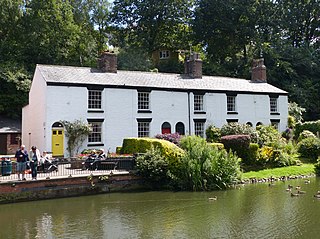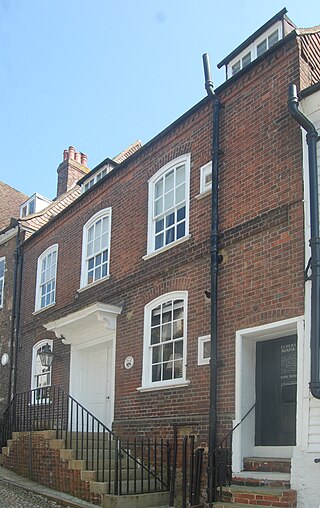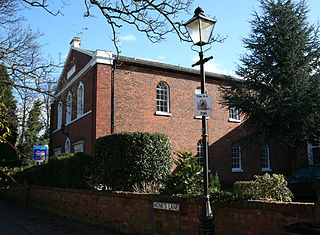
Lymm is a village and civil parish in the Borough of Warrington, Cheshire, England. It incorporates the hamlets of Booths Hill, Broomedge, Church Green, Deansgreen, Heatley, Heatley Heath, Little Heatley, Oughtrington, Reddish, Rushgreen and Statham. At the 2021 United Kingdom census it had a population of 12,700. The village is situated in the northern aspect of Cheshire and borders Greater Manchester to the East and lies 1 mile from the border of Salford to the north.

St Mary's Church is the Anglican parish church of Lymm, Warrington, Cheshire, England, standing on a bank overlooking Lymm Dam. It is a grade II listed building. It is an active church in the diocese of Chester, the archdeaconry of Chester and the deanery of Great Budworth.

Shover's Green Baptist Chapel is a former Strict Baptist place of worship in the hamlet of Shover's Green in East Sussex, England. Shover's Green is in Wealden, one of six local government districts in the English county of East Sussex, and stands on the road between the market town of Wadhurst and the village of Ticehurst in the neighbouring district of Rother. Founded by Strict Baptists from nearby Burwash in 1816, the chapel—one of three Baptist places of worship in Wadhurst parish—continued to serve the community until the 1970s, when it was sold for conversion to a house. Its design is similar to that of the nearby Rehoboth Chapel at Pell Green. The chapel is protected as a Grade II Listed building.

Rye Particular Baptist Chapel is a former Strict Baptist place of worship in Rye, an ancient hilltop town in Rother, one of six local government districts in the English county of East Sussex. Built in the 18th century on the site of a decaying Quaker meeting house, it served Baptists in the town for many years until a new chapel was constructed nearby. The chapel is a Grade II Listed building.

The Wesleyan Methodist Church, also known as the Wesleyan Chapel, is a former Wesleyan Methodist church on Hospital Street, Nantwich, Cheshire, England. Built in 1808, a new façade was added in 1876. The church then seated over a thousand, and was the largest Nonconformist place of worship in the town in the 1880s. It is listed at grade II. The church closed in 2009, after the congregation moved to the former Methodist schoolrooms opposite.

The Congregational Chapel, also known as the Independent Chapel, is a former Congregational or Independent church in Nantwich, Cheshire, England. It is located on Monks Lane, now a pedestrian walkway, opposite the Dysart Buildings and immediately north east of St Mary's Church. Built in 1841–42, it is listed at grade II. The chapel closed in the late 20th century, and the building has been converted to residential use.

Billingshurst Unitarian Chapel is a place of worship in Billingshurst in the English county of West Sussex. The cottage-like building was erected in 1754 for General Baptists, hence its original name of the Billingshurst General Baptist Chapel, but the congregation moved towards Unitarian beliefs in the 19th century, and still maintain these. It is a member of General Assembly of Unitarian and Free Christian Churches, the umbrella body for British Unitarians.

The present Angmering Baptist Church and its predecessor building, known as Church of Christ, are respectively the current and former Baptist places of worship in Angmering, a village in the Arun district of West Sussex, England. Baptist worship in the area can be traced back to 1846, when the "strangely towered" Church of Christ was founded and built. After the Gothic-style chapel became unsuitable for modern requirements, the congregation acquired a nearby barn and converted it into a new church, after which the old building was sold for residential conversion. The church has been designated a Grade II listed building.

Trinity Congregational Church, later known as Union Chapel, is a former place of worship for Congregationalists and Independent Christians in Arundel, an ancient town in the Arun district of West Sussex, England. Protestant Nonconformism has always been strong in the town, and the chapel's founding congregation emerged in the 1780s. After worshipping elsewhere in the town, they founded the present building in the 1830s and remained for many years. Former pastors included the poet George MacDonald. Robert Abraham's distinctive neo-Norman/Romanesque Revival building was converted into a market in the 1980s and has been renamed Nineveh House. The church is a Grade II Listed building.

Horsham Unitarian Church is a Unitarian chapel in Horsham in the English county of West Sussex. It was founded in 1719 to serve the large Baptist population of the ancient market town of Horsham—home of radical preacher Matthew Caffyn—and the surrounding area. The chapel's congregation moved towards Unitarian beliefs in the 19th century, but the simple brick building continued to serve worshippers drawn from a wide area of Sussex. It is one of several places of worship which continue to represent Horsham's centuries-old tradition of Protestant Nonconformism, and is the town's second oldest surviving religious building—only St Mary's, the parish church, predates it. English Heritage has listed the chapel at Grade II for its architectural and historical importance.

Bethel Baptist Chapel is a Strict Baptist place of worship in the village of Wivelsfield in East Sussex, England. The cause was founded in 1763 by members of a chapel at nearby Ditchling; Henry Booker and other worshippers seceded and began to meet at Wivelsfield after hearing a sermon by George Whitefield. Although some members of the new church soon returned to the Ditchling congregation, the cause thrived under Booker's leadership, and the present chapel—a building of "quiet and unassuming elegance" set in its own graveyard—was erected in 1780. It has served the Strict Baptist community continuously since then, and members founded other chapels elsewhere in Sussex during the 18th and 19th centuries. The chapel is a Grade II Listed building.

Ditchling Unitarian Chapel is a Unitarian chapel in Ditchling, a village in the English county of East Sussex. A congregation of General Baptists began to meet in the 17th century in the village, which was a local centre for Protestant Nonconformist worship, and by the time the present simple Vernacular-style chapel was constructed in 1740 a large proportion of the population held Baptist beliefs. Along with other General Baptist chapels in Sussex, the congregation moved towards Unitarian views in the mid-18th century; this caused a schism which resulted in a new chapel being formed at nearby Wivelsfield. The character of the Ditchling chapel was wholly Unitarian by 1800, and it has continued under various names since then. People associated with the chapel include William Hale White, Henry Acton, Adrian Boult—who was married there—and G. K. Chesterton. The chapel is set back from Ditchling's main street and has an adjoining house and graveyard, all of which contribute to the character of the conservation area which covers the centre of Ditchling village. English Heritage has listed the chapel at Grade II for its architectural and historical importance.

Zoar Strict Baptist Chapel is a Strict Baptist place of worship in the hamlet of Lower Dicker in the English county of East Sussex. Founded in 1837 and originally known as The Dicker Chapel, the "large and impressive" Classical/Georgian-style building stands back from a main road in a rural part of East Sussex. The 800-capacity building included a schoolroom and stables when built, and various links exist between people and pastors associated with the chapel and other Strict Baptist and Calvinistic causes in the county, which is "particularly well endowed with [such] chapels".

In the English civil parish of Lymm, there are 55 buildings that are recorded in the National Heritage List for England as designated listed buildings. Of these, one is classified as Grade I and one as Grade II*; the remainder are at Grade II. Lymm is in the borough of Warrington and the ceremonial county of Cheshire. In the early 16th century, the civil parish was a prosperous agricultural area, divided into two manors, Lymm and Oughtrington. The Grade-II*-listed Lymm Hall, the oldest listed building in the civil parish, dates from the late 16th century and occupies the site of a medieval building which was the manorial seat. The largest settlement in the civil parish is Lymm, which has expanded into a small town whilst retaining its village centre. Several other small settlements within the parish remain separate, including Oughtrington; Oughtrington Hall dates from around 1810.

Bugby Chapel is an 18th-century former chapel in the centre of Epsom, a suburban town in Surrey, England. Known by this name in reference to its Calvinistic founder William Bugby, it was also known as East Street Chapel and later, as it passed into the ownership of different religious groups, as Salem Unitarian Chapel, Salem Baptist Chapel and the Epsom and District Synagogue. More than 200 years of religious use ended when it was converted into an office. The chapel is a Grade II Listed building.

Meadrow Unitarian Chapel is a Unitarian chapel in the Farncombe area of Godalming, Surrey, England. It is part of the London District and South Eastern Provincial Assembly of Unitarian and Free Christian Churches, one of 16 districts within the General Assembly of Unitarian and Free Christian Churches, the umbrella organisation for British Unitarians.

The building formerly known as Park Lane Chapel is a former Strict Baptist chapel in the ancient town of Farnham in Surrey, England. Now a house, it was in religious use for nearly 150 years and housed a congregation whose origins go back to informal meetings in the 1840s. After Nisan Samuel, a Polish Jew, arrived in England and converted to Christianity, he took charge of these ad hoc meetings and formalised them into a Strict Baptist church. After he moved on, the congregation bought land and built a chapel. The small stone and brick building has been listed at Grade II for its architectural and historical importance.

Five Ash Down Independent Chapel is an independent Evangelical church in the Reformed (Calvinist) tradition in the hamlet of Five Ash Down, East Sussex, England. Founded in 1773 in the house of a local man, Thomas Dicker senior, the cause developed so rapidly that a church was founded and a permanent building erected for the congregation 11 years later. The church was run along Calvinistic lines at first, in common with many new chapels in late 18th-century Sussex, and an early group of seceders from the congregation founded a chapel in nearby Uckfield which was run in accordance with Baptist theology. The Five Ash Down chapel has been described as "the parent of many other places [of worship] both Baptist and Independent" across Sussex, and it has continued into the 21st century—now as a small Evangelical fellowship but still worshipping in the original chapel, whose present appearance is a result of expansion and refronting during the Victorian era.

Uckfield Baptist Church is a Baptist congregation based in the town of Uckfield in East Sussex, England. Although services now take place in a school, the cause—founded in 1785 by seceders from the nearby Five Ash Down Independent Chapel—had its own chapel from 1789 until 2005, when the building closed and was sold for residential conversion. The "simple brick chapel" was rebuilt in 1874 and has been listed at Grade II for its architectural and historical importance.

Yapton Free Church is an Evangelical church in the village of Yapton in West Sussex, England. The "pretty flint building" dates from 1861, when it was built for a group of Congregational worshippers who had been active in the area for several years. Growth in membership during the 20th century meant that by the 1990s some services and activities were held in larger premises elsewhere, but the chapel remains registered as a place of worship. The church is denominationally independent but is associated with a worldwide cross-denomination network of churches called Partners in Harvest. The church building has been listed at Grade II by Historic England for its architectural and historical importance.





















